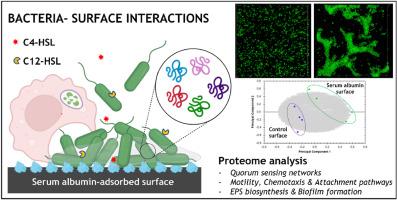血清白蛋白在生物材料表面的预吸附调节细菌与表面的相互作用并改变细菌的生理反应
IF 10.2
1区 医学
Q1 ENGINEERING, BIOMEDICAL
引用次数: 0
摘要
当生物医学设备被植入人体时,其表面最初会遇到生物液体,导致各种宿主蛋白质的自然吸附。这种蛋白质吸附层改变了生物材料表面的固有特性,在植入物和细菌之间的相互作用中起着至关重要的作用。在这里,我们研究了白蛋白(最丰富的血液蛋白)的吸附层对三种不同菌株(金黄色葡萄球菌、表皮葡萄球菌和铜绿假单胞菌)的粘附和生物膜形成的影响。我们发现血清白蛋白层对细菌粘附的影响是菌株依赖的。白蛋白预吸附降低了金黄色葡萄球菌和表皮葡萄球菌对PDMS表面的初始附着,但对铜绿假单胞菌没有影响。然而,随着孵育时间的延长,白蛋白涂层表面显著促进铜绿假单胞菌的附着和生物膜的形成。此外,这种生物膜改变与巨噬细胞介导的细菌清除率降低有关。蛋白质组学分析进一步揭示了铜绿假单胞菌暴露于白蛋白涂层表面后的显著生理变化。这些改变特别与涉及表面定植的分子途径相关,包括群体感应、运动、粘附和生物膜形成。这些发现表明,血清白蛋白的吸附不仅影响细菌的初始粘附,而且改变了细菌与生物材料表面接触后的适应性反应。这项研究提供了对复杂的细菌表面相互作用的更深入的理解,有助于未来预防种植体相关感染的策略的发展。本文章由计算机程序翻译,如有差异,请以英文原文为准。

Pre-adsorption of serum albumin on biomaterial surfaces modulates bacteria-surface interactions and alters bacterial physiological responses
When a biomedical device is implanted into the body, its surface initially encounters biological fluids, resulting in the natural adsorption of various host proteins. This protein-adsorbed layer alters the inherent properties of the biomaterial surface and plays a crucial role in interactions between the implant and bacteria. Here, we investigated the influence of an adsorbed layer of albumin, the most abundant blood protein, on the adhesion and biofilm formation of three different bacterial strains: Staphylococcus aureus, Staphylococcus epidermidis, and Pseudomonas aeruginosa. We found that the effect of a serum albumin layer on bacterial adhesion was strain-dependent. Albumin pre-adsorption reduced the initial attachment of S. aureus and S. epidermidis to PDMS surfaces but had no impact on P. aeruginosa. However, with prolonged incubation, albumin-coated surfaces significantly promoted P. aeruginosa attachment and biofilm formation. Additionally, this biofilm alteration was associated with reduced macrophage-mediated bacterial clearance. Proteomic analysis further revealed significant physiological changes in P. aeruginosa upon exposure to albumin-coated surfaces compared to uncoated controls. These alterations were particularly associated with molecular pathways involved in surface colonization, including quorum sensing, motility, adhesion, and biofilm formation. These findings suggest that serum albumin adsorption not only affects the initial adhesion of bacteria but also modifies their adaptive responses upon contact with the biomaterial surface. This study provides a deeper understanding of the complex bacteria-surface interactions, contributing to the development of future strategies for preventing implant-associated infections.
求助全文
通过发布文献求助,成功后即可免费获取论文全文。
去求助
来源期刊

Materials Today Bio
Multiple-
CiteScore
8.30
自引率
4.90%
发文量
303
审稿时长
30 days
期刊介绍:
Materials Today Bio is a multidisciplinary journal that specializes in the intersection between biology and materials science, chemistry, physics, engineering, and medicine. It covers various aspects such as the design and assembly of new structures, their interaction with biological systems, functionalization, bioimaging, therapies, and diagnostics in healthcare. The journal aims to showcase the most significant advancements and discoveries in this field. As part of the Materials Today family, Materials Today Bio provides rigorous peer review, quick decision-making, and high visibility for authors. It is indexed in Scopus, PubMed Central, Emerging Sources, Citation Index (ESCI), and Directory of Open Access Journals (DOAJ).
 求助内容:
求助内容: 应助结果提醒方式:
应助结果提醒方式:


